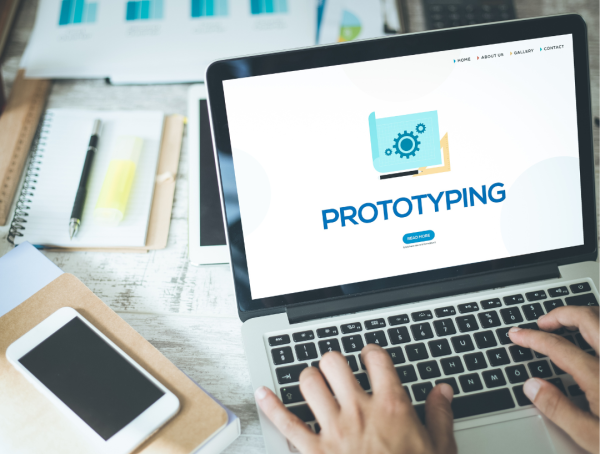Introduction
In modern times like these, the pressure to innovate and deliver outstanding digital products is higher than ever. With consumer expectations constantly evolving, businesses must find ways to create products that not only meet these demands but also stand out in a crowded market. One of the most effective tools in achieving this goal is prototyping.
Prototyping is the process of creating a preliminary version of a product to test its functionality, design, and user experience before investing in full-scale development. It allows designers, developers, and stakeholders to visualize ideas, identify potential issues early on, and iterate quickly to refine the final product. The power of prototyping lies in its ability to bridge the gap between concept and reality, enabling teams to build better digital products through experimentation and user feedback.
Understanding the Importance of Prototyping
Prototyping is essential for several reasons. Firstly, it helps mitigate risks associated with product development by allowing teams to validate assumptions and uncover flaws in the early stages. Instead of investing time and resources into building a complete product only to discover flaws later, prototyping enables teams to fail fast and iterate efficiently.

Secondly, prototyping facilitates communication and collaboration among cross-functional teams. By visualizing ideas in a tangible form, designers can effectively communicate their vision to developers, marketers, and other stakeholders, ensuring everyone is aligned on the product’s objectives and requirements. This collaborative approach fosters creativity and innovation, leading to more robust and user-centric solutions.
Thirdly, prototyping accelerates the design and development process. Unlike traditional waterfall methods where each phase is completed sequentially, prototyping allows for an iterative approach where ideas are tested, refined, and validated continuously. This iterative cycle reduces time to market and enables teams to respond swiftly to changing market dynamics and user feedback.
Types of Prototypes
Prototypes come in various forms, each serving a specific purpose in the product development lifecycle. Some common types of prototypes include:
- Low-Fidelity Prototypes: These are simple, rough sketches or wireframes that convey basic design concepts and functionalities. Low-fidelity prototypes are useful for exploring different ideas quickly and gathering initial feedback from stakeholders. A low-fidelity prototype is a simple diagram of an early-stage design concept. UX design teams use them to quickly test an idea, identify gaps and pitfalls, and discard product designs that don’t resonate with users. An important step in the design thinking process, low-fidelity prototyping drives ideation and innovation for basic page layout, content organization, and user flow.
- High-Fidelity Prototypes: Unlike low-fidelity prototypes, high-fidelity prototypes resemble the final product closely in terms of design and functionality. They offer a more detailed representation of the user interface and interactions, allowing for more realistic user testing and feedback. High-fidelity prototyping plays a key role in the later stages of the design process, from usability testing to developer handoff. Design teams use hi-fi prototypes to vet a digital product’s user flow and user interface or UI design with their target audience. Designers also share high-fidelity prototypes with key stakeholders to demonstrate key design features, interactions, and workflows for input and approval. While high-fidelity prototypes closely resemble your final product, low-fidelity prototypes do not. Low-fidelity prototypes range from rough paper prototypes to basic digital wireframes.
They don’t include complex interactions, animations, or transitions—but hi-fi prototypes do. Designers create lo-fi prototypes in the early stages of the design process to communicate and test high-level design concepts. Teams need higher prototyping fidelity later, when they’re ready to refine designs and solve usability issues before development. Hi-fi prototypes offer the level of detail stakeholders need to approve designs with confidence. - Interactive Prototypes: Interactive prototypes simulate the user experience by incorporating clickable elements and transitions. They enable users to interact with the product as they would with the final version, providing valuable insights into usability and navigation. In this course, you’ll explore how to work with AI in harmony and incorporate it into your design process to elevate your career to new heights
- Functional Prototypes: Functional prototypes include basic functionality and features, allowing users to perform tasks and accomplish goals within the prototype. While not fully functional like the final product, they provide a realistic simulation of the user experience. We have all heard the phrase ‘a picture is worth a thousand words,’ and when it comes to product development, a functional prototype is even more valuable.A functional prototype helps product designers and engineers to bring their ideas to life and to test the effectiveness of the design.
The Prototyping Process
The prototyping process typically involves the following stages:
- Identify Objectives and Requirements: Define the goals of the prototype and outline the features and functionalities it should include. Consider the target audience and their needs to ensure the prototype aligns with user expectations.
- Conceptualization and Ideation: Generate ideas and concepts for the prototype through brainstorming sessions, user research, and market analysis. Explore different design approaches and select the most promising ones to pursue further.
- Prototype Development: Create the prototype using appropriate tools and techniques based on the chosen design concepts. Start with low-fidelity prototypes to explore ideas rapidly before progressing to higher fidelity versions.
- User Testing and Feedback: Conduct usability testing with target users to gather feedback on the prototype’s design, functionality, and user experience. Iterate based on the feedback received, making necessary adjustments and refinements to improve the prototype.
- Validation and Iteration: Validate the prototype against the project objectives and requirements, ensuring it meets the desired outcomes. Iterate as needed to address any issues or shortcomings identified during testing.
- Finalization and Handoff: Once the prototype meets the necessary criteria, finalize the design and prepare it for handoff to development teams for implementation. Document key insights and learnings from the prototyping process to inform future iterations and improvements.

Benefits of Prototyping
Prototyping offers numerous benefits throughout the product development lifecycle:
- Reduced Development Costs: By identifying and addressing issues early on, prototyping helps minimize the cost of rework and changes during the later stages of development.
- Improved User Experience: By involving users in the design process through testing and feedback, prototyping enables teams to create products that are intuitive, easy to use, and tailored to user needs.
- Faster Time to Market: The iterative nature of prototyping allows for quicker iterations and decision-making, resulting in shorter development cycles and faster time to market.
- Enhanced Stakeholder Alignment: Prototypes serve as visual representations of the product, making it easier to communicate ideas and gather feedback from stakeholders. This alignment helps ensure everyone is on the same page regarding the product’s direction and features.
- Increased Innovation: Prototyping encourages experimentation and exploration, leading to the discovery of innovative solutions and features that may not have been apparent initially.
Case Studies: Real-World Examples
Several companies have successfully leveraged prototyping to create innovative digital products. For example:
Airbnb: Before becoming the global hospitality platform it is today, Airbnb used prototyping to validate its concept of allowing people to rent out their homes to travelers. By creating simple prototypes and testing them with users, Airbnb was able to refine its offering and address early concerns, paving the way for its rapid growth.
Google: Google is known for its “design sprint” methodology, which involves prototyping and testing ideas in a compressed timeframe. This approach has led to the development of popular products such as Gmail and Google Docs, which were refined through rapid prototyping and user feedback.
Apple: Apple is renowned for its focus on design and user experience, which is evident in its products such as the iPhone and iPad. Prototyping plays a crucial role in Apple’s product development process, allowing designers to iterate quickly and create products that delight users.
Conclusion
In conclusion, prototyping is a powerful tool for building better digital products. By enabling teams to visualize ideas, gather feedback, and iterate quickly, prototyping helps mitigate risks, accelerate development, and deliver products that meet user needs and expectations. Whether you’re a startup looking to validate a new concept or an established company aiming to innovate, incorporating prototyping into your product development process can lead to more successful outcomes and satisfied customers.
Embrace the power of prototyping and unlock the potential to create exceptional digital experiences.
Related Posts





